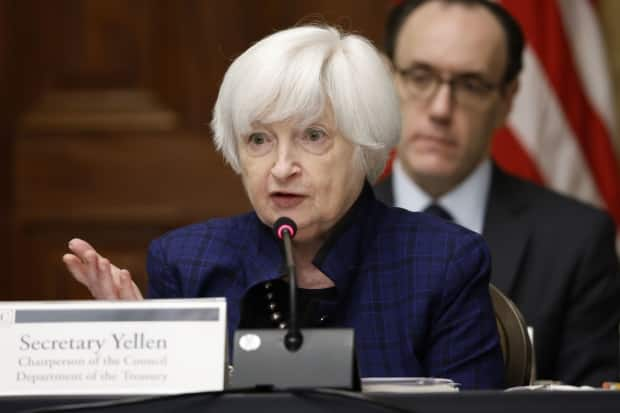The U.S. debt limit is again stoking fears across the globe. Why not just scrap the thing?

With the U.S. government stoking global economic fears as it faces yet another standoff over raising the debt ceiling, some economic analysts and lawmakers are proposing a relatively simple solution to permanently resolve this issue:
Just scrap the thing.
"I don't think there's any reason to have it exist anymore," said Douglas Holtz-Eakin, former director of the Congressional Budget Office, who is the current president of the right-wing think-tank American Action Forum.
The biggest problem with the ceiling, said Holtz-Eakin and other observers, is that it has become so politicized, and a dangerous political bargaining chip that holds the economy hostage in order to extract political demands.
"Congress is increasingly willing to run with scissors on this," said Laura Blessing, a senior fellow at Georgetown University's Government Affairs Institute. "The best-case scenario, abolish the thing."
A handful of Democratic lawmakers are trying to do that, and have co-sponsored the reintroduction of legislation calling for a repeal of the national debt ceiling.
"We should get rid of the debt ceiling. There's no other function than to let hostage-takers ply their trade," Massachusetts Sen. Elizabeth Warren told CBC News Tuesday.
Rhode Island Senator Sheldon Whitehouse, chair of the senate budget committee, said in a statement Tuesday that the threat of default "puts a very fine point on the need to get rid of this arbitrary mechanism that offers no benefits yet carries with it the power to deliver serious damage."

U.S. mostly an outlier
Currently, U.S. President Joe Biden supports increasing the government's $31.4 trillion legal borrowing limit. But Republican House Speaker Kevin McCarthy and other GOP lawmakers want a deal that guarantees trillions of dollars in spending cuts before they sign on to raising the debt limit.
On Tuesday, congressional leaders from both parties met with Biden to address the issue, but little progress was made.
The debt ceiling is the government's borrowing limit that can only be raised through congressional authorization. That money, according to the U.S. Treasury Department, is needed for the government to meet its existing legal obligations, including social security and Medicare benefits, military salaries, interest on the national debt, tax refunds, and other payments.
WATCH | Biden wants to lift the debt ceiling:
The U.S is mostly an outlier when it comes to setting such debt ceilings. Denmark also sets a debt ceiling, but as noted by Mrugank Bhusari, an assistant director with the Atlantic Council's GeoEconomics Center, the Danish government sets the ceiling so high that it will not be crossed, "rendering it no more than a formality."
A few other countries, including the European Union, have their debt ceiling set as a percentage of GDP (60 per cent in the case of the EU). But Bhusari notes that, unlike these other countries, the U.S. is "unique in its inability to find workarounds."
On Jan. 19, the U.S. federal government actually reached its limit on the amount of money it was authorized to borrow: $31.4 trillion. That prompted the U.S Treasury Department to use what they described as "extraordinary measures" to stave off a default — those measures included emergency changes to certain government accounts.
But in a recent letter to McCarthy, Treasury Secretary Janet Yellen said that those measures could end as early as June 1, meaning the U.S., at that time, would be in default of its obligations.
Many economists have forecast dire economic consequences as a result of a default, which could include a credit rating downgrade, impact on borrowing, negative impact on the dollar, and potential havoc in the financial markets, with job losses in the thousands, if not millions — and all leading to a recession.
'Does exactly the opposite'
Holtz-Eakin said that up until around the First World War, Congress would vote on every debt issue, which was unwieldy when trying to finance a war.
They enacted a debt limit so the Treasury Department could borrow when it needed, just underneath the limit. And when that limit needed to be raised, the department could consult with Congress, he said.
"Ironically, it was meant to make life easier for Treasury. And now it does exactly the opposite."
How national debt in the U.S. — and the debt ceiling — has risen
For decades, the vote to raise the debt limit has generally gone through without incident. But in 2011 that changed, as the House, under Republican control and influenced by the Tea Party, ran on a pledge to vote on every dollar spent, Holtz-Eakin said.
"The Republicans said, 'We're going to vote on every dime,' which meant they now had the votes for debt limit increase. Almost none of them wanted to do it," Holtz-Eakin said. "Then that partisanship slowly began to infect the Senate as well. And now we're at a position where it's become this real political hot potato."
Those who support keeping the debt limit will say that it forces Congress to "periodically look at itself in the mirror and say 'we're spending too much, let's get our act together,'" Hotlz-Eakin said.
"But I just don't believe that evidence suggests that's true."
'We should not be putting the U.S. economy hostage'
Historically, the debt ceiling has not been a tool for fiscal restraint, said Blessing. It may have had some impact around the margins, but certainly nothing significant, she said.
"If you want to talk about meaningful fiscal restraint of a transformative nature, I cannot imagine a push, a statutory and/or procedural tool that is more ill-suited for that kind of a far-reaching and expertise-requiring exercise as the debt ceiling."
Instead, said Louise Sheiner, policy director for the Hutchins Center on Fiscal and Monetary Policy at the Brookings Institution, the debt ceiling is used as a political threat.
"We should not be putting the U.S. economy hostage and we should not be putting the credibility of the U.S. government hostage like this," she said. "Not a good way of getting political leverage."

Although a handful of Democratic legislators may be pushing to scrap the ceiling, Blessing said she's not optimistic it would pass through. Biden himself, just last year, said the idea of scrapping the debt limit would be "irresponsible."
"It hasn't captured enough of a priority among political actors of both parties in the U.S," Blessing said. "[And] realistically, we see a number of politicians who think of themselves as fiscal hawks."
What are the alternatives?
While abolishing the debt ceiling may not be in the cards, there have been other alternatives suggested to work around it.
In 2011, during a debt limit standoff, then-senate minority leader Mitch McConnell came up with a plan that would allow then-president Barack Obama to raise the debt limit. This would put the burden on the president, and allow it to pass through, as long as two-thirds of Congress didn't pass a resolution rejecting the president's request.
White House officials have also reportedly been looking at a clause in the 14th Amendment that potentially would allow the president to raise the limit, arguing it would be unconstitutional for the U.S. to not make good on its payment obligations.
Finally, there's the trillion-dollar coin. The idea here is that the U.S. Mint could create $1-trillion coins, deposit them at the Federal Reserve, and the government could pay its debt obligations with those funds.
But many expert have problems with these other avenues to curtail the debt ceiling problem.
"I think they're gimmicky," said Holtz-Eakin "But I think they also run into the following substantive problem, and that is they will be perceived as Hail Mary passes of desperation by financial market participants, rating agencies, and they will impair the future credit of the United States."


